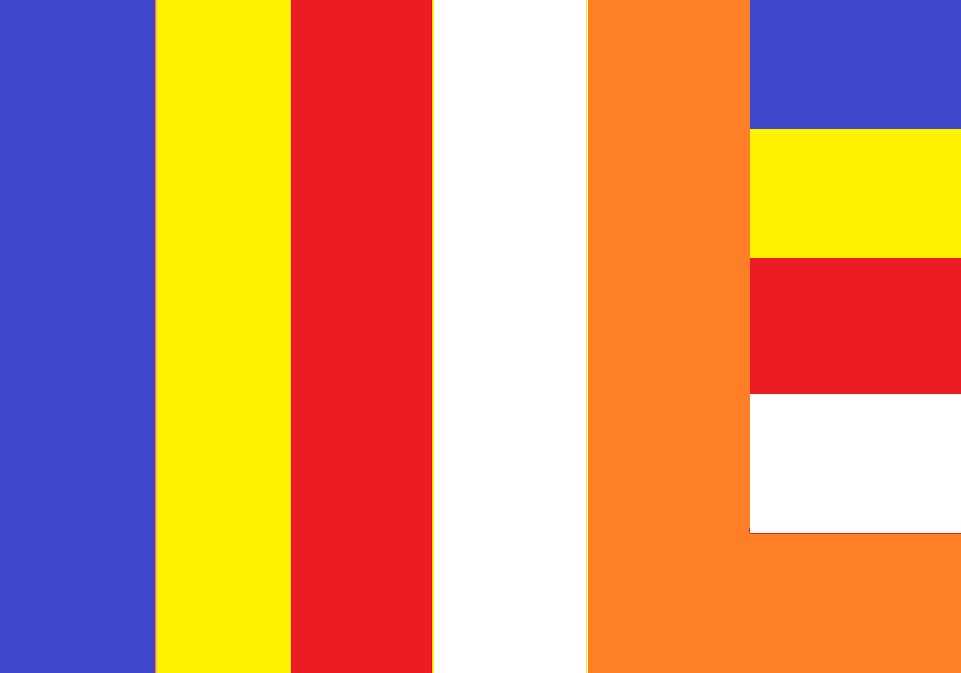Buddhist festivals prominently display the colors of the Buddhist flag along with Buddha statues and other symbolic items. However, the meaning of the flag goes far beyond the bright colors on display. This is because the colors portray the aura which emanated from the head of the Buddha after he achieved enlightenment. Similar to Buddhist mudras, the colors of the flag have also come to reflect the virtues of Buddhism.
The Buddhist flag’s five colors are vertically displayed from left to right. Additionally, the 6th and final rectangular band is a blend of the 5 colors and displayed perpendicular to the other bands. However, the sixth band is not required and isn’t always included.

The Buddhist Colors and Their Meanings
- Nila (Blue) – Spirit of Universal Compassion
- Pita (Yellow) – Middle path of emptiness and avoiding extremes.
- Lohita (Red) – Merits of practice – achievement, wisdom, virtue, fortune and dignity.
- Odata (White) – Purity of Dharma which leads to liberation outside time or space.
- Manjesta (Orange) – Wisdom of the Buddha’s teachings.
The Buddha’s birth, paranirvana and enlightenment all occurred on the same day. Indeed, this special day is known by several names throughout the world. This includes Vesak Day, Buddha Purnima, Buddha Day and also informally as “Buddha’s Birthday”. Additionally, celebrations occur around the world every year in Buddhist countries. As a result, the Buddhist colors are prominently on display using many variations such as independent flags, formations and also the formal flag itself.

Common Variations of the Buddhist Flag
There are several common variations of the Buddhist flag which incorporate additional Buddhist symbols onto the colors. For example, it is common to see the Dharmachakra superimposed onto the traditional flag. Additionally, the swastika is also a prominent symbol.
Unfortunately, in modern times the swastika has become controversial due to its use by the Nazis during the 20th century. Nonetheless, it’s an auspicious symbol that dates back over 11,000 years.

History of the Buddhist Flag
In contrast with the long and venerable history of Buddhism, the Buddhist flag has more recent beginnings. Ironically, the development of the flag was in response to British Colonialism in Sri Lanka. Unfortunately, in Sri Lanka, Buddhism had become repressed by the British. Therefore, the Colombo Committee designed the first flag in 1858. As a result, the flag served to symbolize Buddhism and also assist with the revival of Buddhism in Sri Lanka.
The flag was first hoisted in celebration of Vesak day on May 28, 1885. However, the original elongated flag design was subsequently adjusted to suit conventional proportions.
The hoisting of the flag on May 28, 1885 has special significance because it was the first Vesak Day public holiday under British rule. Furthermore, the World Fellowship of Buddhists adopted the flag of Buddhism as their international symbol in 1952. As a result, Buddhists from over 60 countries have accepted the flag as a symbol of Buddhist unity.
Nationality of the Buddhist Flag
Although the flag is nonsectarian, it is commonly displayed alongside national and state flags. This can be an indication that Buddhism is the national religion, or an indication that there is a large Buddhist population.
In Malaysia, Islam is the national religion. However, there is a large Buddhist population in certain areas such as Penang. As a result, it is common to see the Buddhist colors on display in combination with other flags.


